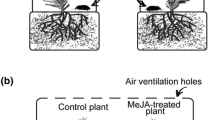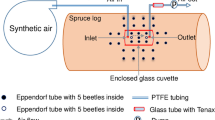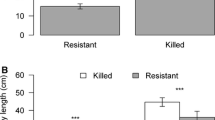Abstract
We treated Norway spruce (Picea abies) stems with methyl jasmonate (MeJA) to determine possible quantitative and qualitative effects of induced tree defenses on pheromone emission by the spruce bark beetle Ips typographus. We measured the amounts of 2-methyl-3-buten-2-ol and (S)-cis-verbenol, the two main components of the beetle’s aggregation pheromone, released from beetle entrance holes, along with phloem terpene content and beetle performance in MeJA-treated and untreated Norway spruce logs. As expected, phloem terpene levels were higher and beetle tunnel length was shorter (an indication of poor performance) in MeJA-treated logs relative to untreated logs. Parallel to the higher phloem terpene content and poorer beetle performance, beetles in MeJA-treated logs released significantly less 2-methyl-3-buten-2-ol and (S)-cis-verbenol, and the ratio between the two pheromone components was significantly altered. These results suggest that host resistance elicited by MeJA application reduces pheromone emission by I. typographus and alters the critical ratio between the two main pheromone components needed to elicit aggregation. The results also provide a mechanistic explanation for the reduced performance and attractivity observed in earlier studies when bark beetles colonize trees with elicited host defenses, and extend our understanding of the ecological functions of conifer resistance against bark beetles.




Similar content being viewed by others
References
Bakke A (1981) Inhibition of the response in Ips typographus to the aggregation pheromone: field evaluation of verbenone and ipsenol. Z Angew Entomol 92:172–177
Bearfield JC, Henry AG, Tittiger G, Blomquist GJ, Ginzel MD (2009) Two regulatory mechanisms of monoterpenoid pheromone production in Ips spp. of bark beetles. J Chem Ecol 35:689–697
Berryman AA (1972) Resistance of conifers to invasion by bark beetle–fungi associations. Bioscience 22:598–602
Birgersson G (1989) Host tree resistance influencing pheromone production in Ips typographus (Coleoptera: Scolytidae). Holarctic Ecol 12:451–456
Birgersson G, Bergström G (1989) Volatiles released from individual spruce bark beetle entrance holes: quantitative variations during the first week of attack. J Chem Ecol 15:2465–2484
Birgersson G, Leufvén A (1988) The influence of host tree response to Ips typographus and fungal attack on production of semiochemicals. Insect Biochem 18:761–770
Birgersson G, Schlyter F, Löfqvist J, Bergström G (1984) Quantitative variation of pheromone components in the spruce bark beetle Ips typographus from different attack phases. J Chem Ecol 10:1029–1055
Birgersson G, Schlyter F, Bergström G, Löfqvist J (1988) Individual variation in aggregation pheromone content of the bark beetle, Ips typographus. J Chem Ecol 14:1737–1761
Blomquist GJ, Figueroa-Teran R, Aw M, Song M, Gorzalski A, Abbott NL, Chang E, Tittiger C (2010) Pheromone production in bark beetle. Insect Biochem Mol Biol 40:699–712
Cates RG, Alexander H (1982) Host resistance and susceptibility. In: Mitton JB, Sturgeon KB (eds) Bark beetle in North American conifers: a system for the study of evolutionary ecology. University of Texas Press, Austin, pp 212–263
Christiansen E, Bakke A (1988) The spruce bark beetle of Eurasia. In: Berryman AA (ed) Dynamics of forest insect populations. Plenum, New York, pp 479–503
Christiansen E, Krokene P (1999) Can Norway spruce trees be ‘vaccinated’ against attack by Ips typographus? Agric For Entomol 1:185–187
Christiansen E, Krokene P, Berryman AA, Franceschi VR, Krekling T, Lieutier F, Lönneborg A, Solheim H (1999) Mechanical injury and fungal infection induce acquired resistance in Norway spruce. Tree Physiol 19:399–403
Cook SP, Hain FP (1988) Toxicity of host monoterpenes to Dendroctonus frontalis and Ips calligraphus (Coleoptera: Scolytidae). J Entomol Sci 23:287–292
Creelman RA, Mullet JE (1997) Biosynthesis and action of jasmonates in plants. Annu Rev Plant Physiol Plant Mol Biol 48:355–381
Dickens JC (1981) Behavioural and electrophysiological responses to the bark beetle Ips typographus to potential pheromone components. Physiol Entomol 6:251–261
Engelberth J (2006) Essay 13.8: smelling the danger and getting prepared: volatile signals as priming agents in defense response. Plant Physiology, 4th edn Online. http://www.plantphys.net Accessed 02/Feb/2010
Erbilgin N, Krokene P, Christiansen E, Zeneli G, Gershenzon J (2006) Exogenous application of methyl jasmonate elicits defenses in Norway spruce (Picea abies) and reduces host colonization by the bark beetle Ips typographus. Oecologia 148:426–436
Feyereisen R (1999) Insect P450 enzymes. Annu Rev Entomol 44:507–533
Franceschi VR, Krekling T, Christiansen E (2002) Application of methyl jasmonate on Picea abies (Pinaceae) stems induces defense-related responses in phloem and xylem. Am J Bot 89:578–586
Franceschi VR, Krokene P, Christiansen E, Krekling T (2005) Anatomical and chemical defenses of conifer bark against bark beetles and other pests. New Phytol 167:353–376
Huber DPW, Erickson ML, Leutenegger CM, Bohlmann J, Seybold SJ (2007) Isolation and extreme sex-specific expression of cytochrome P450 genes in the bark beetle, Ips paraconfusus, following feeding on the phloem of host ponderosa pine, Pinus ponderosa. Insect Mol Biol 16:335–349
Hudgins JW, Christiansen E, Franceschi VR (2003) Methyl jasmonate induces changes mimicking anatomical and chemical defenses in diverse members of the Pinaceae. Tree Physiol 23:361–371
Ivarsson P, Schlyter F, Birgersson G (1993) Demonstration of de novo pheromone biosynthesis in Ips duplicatus (Coleoptera: Scolytidae): inhibition of ipsdienol and Emyrcenol production by compactin. Insect Biochem Mol Biol 23:655–662
Keeling CI, Bohlmann J (2006) Genes, enzymes, and chemicals of terpenoid diversity in the constitutive and induced defence of conifers against insects and pathogens. New Phytol 170:657–675
Klimetzek D, Francke W (1980) Relationship between the enantiomeric composition of α-pinene in host trees and the production of verbenols in Ips species. Experentia 36:1343–1344
Kozlowski G, Buchala A, Metraux JP (1999) Methyl jasmonate protects Norway spruce [Picea abies (L.) Karst.] seedlings against Pythium ultimum Trow. Physiol Mol Plant Path 55:53–58
Krekling T, Franceschi VR, Berryman AA, Christiansen E (2000) The structure and development of polyphenolic parenchyma cells in Norway spruce (Picea abies) bark. Flora 195:354–369
Krokene P, Solheim H, Krekling T, Christiansen E (2003) Inducible anatomical defense responses in Norway spruce stems and their possible role in induced resistance. Tree Physiol 23:191–197
Lanne BS, Ivarsson P, Johnsson P, Bergström G, Wassgren AB (1989) Biosynthesis of 2-methyl-3-buten-2-ol, a pheromone component of Ips typographus (Coleoptera: Scolytidae). Insect Biochem 19:163–168
Leufvén A, Bergström G, Falsen E (1984) Interconversion of verbenols and verbenone by identified yeasts isolated from the spruce bark beetle Ips typographus. J Chem Ecol 10:1349–1361
Martin D, Tholl D, Gershenzon J, Bohlmann J (2002) Methyl jasmonate induces traumatic resin ducts, terpenoid resin biosynthesis, and terpenoid accumulation in developing xylem of Norway spruce stems. Plant Physiol 129:1003–1018
Martin D, Gershenzon J, Bohlmann J (2003) Induction of volatile terpene biosynthesis and diurnal emission by methyl jasmonate in foliage of Norway spruce. Plant Physiol 132:1586–1599
Phillips MA, Croteau RB (1999) Resin-based defense in conifers. Trends Plant Sci 4:184–190
Raffa KF (2001) Mixed messages across multiple trophic levels: the ecology of bark beetle chemical communication systems. Chemoecology 11:49–65
Raffa KF, Berryman AA (1983) The role of host plant-resistance in the colonization behavior and ecology of bark beetles (Coleoptera, Scolytidae). Ecol Monog 53:27–49
Raffa KF, Aukema BH, Bentz BJ, Carroll AL, Hicke JA, Turner MG, Romme WH (2008) Cross-scale drivers of natural disturbances prone to anthropogenic amplification: the dynamics of bark beetle eruptions. Bioscience 58:501–517
Sandstrom P, Welch WH, Blomquist GJ, Tittiger C (2006) Functional expression of a bark beetle cytochrome P450 that hydroxylates myrcene to ipsdienol. Insect Biochem Mol Biol 36:835–845
Schlyter F, Birgersson G, Byers J, Löfqvist J, Bergström G (1987a) Field response of spruce bark beetle, Ips typographus, to aggregation pheromone candidates. J Chem Ecol 13:701–716
Schlyter F, Birgersson G, Löfqvist J (1987b) Behavioral sequence in the attraction of the bark beetle pheromone and terpene attraction in the bark beetle Ips typographus to pheromone sources. Physiol Entomol 12:185–196
Schmidt A, Zeneli G, Hietala AM, Fossdal CG, Krokene P, Christiansen E, Gershenzon J (2005) Induced chemical defences in conifers: biochemical and molecular approaches to studying their function. In: Romeo JT (ed) Chemical ecology and phytochemistry in forest ecosystems. Elsevier, Amsterdam, pp 1–28
Thaler JS (1999) Jasmonic acid mediated interactions between plants, herbivores, parasitoids, and pathogens: a review of field experiments in tomato. In: Agrawal AA, Tuzun S, Bent E (eds) Induced plant defenses against pathogens and herbivores: biochemistry, ecology and agriculture. APS, St. Paul, pp 319–334
Viiri H, Annila E, Kitunen V, Niemelä P (2001) Induced responses in stilbenes and terpenes in fertilized Norway spruce after inoculation with blue-stain fungus, Ceratocystis polonica. Trees 15:112–122
Wallin KF, Raffa KF (2000) Influences of host chemicals and internal physiology on the multiple steps of postlanding host acceptance behavior of Ips pini (Coleoptera: Scolytidae). Environ Entomol 29:442–453
Wermelinger B (2004) Ecology and management of the spruce bark beetle Ips typographus—a review of recent research. For Ecol Manag 202:67–82
Wood DL (1982) The role of pheromones, kairomones, and allomones in the host selection and colonization behavior of bark beetles. Annu Rev Entomol 27:411–446
Worrell R (1983) Damage by the spruce bark beetle in south Norway 1970–80: a survey, and factors affecting its occurrence. Medd Nor Inst Skogforsk 38:1–34
Zeneli G, Krokene P, Christiansen E, Krekling T, Gershenzon J (2006) Methyl jasmonate treatment of mature Norway spruce (Picea abies) trees increases the accumulation of terpenoid resin components and protects against infection by Ceratocystis polonica, a bark beetle-associated fungus. Tree Physiol 26:977–988
Zhao T, Krokene P, Björklund N, Långström B, Solheim H, Christiansen E, Borg-Karlson AK (2010) The influence of Ceratocystis polonica inoculation and methyl jasmonate application on terpene chemistry of Norway spruce, Picea abies. Phytochemistry 71:1332–1341
Acknowledgments
This study was supported by FORMAS (The Swedish Research Council for Environment, Agricultural Sciences and Spatial Planning), Norwegian Forest and Landscape Institute and University of Alberta, Canada.
Author information
Authors and Affiliations
Corresponding author
Additional information
Communicated by Julia Koricheva.
Rights and permissions
About this article
Cite this article
Zhao, T., Borg-Karlson, AK., Erbilgin, N. et al. Host resistance elicited by methyl jasmonate reduces emission of aggregation pheromones by the spruce bark beetle, Ips typographus . Oecologia 167, 691–699 (2011). https://doi.org/10.1007/s00442-011-2017-x
Received:
Accepted:
Published:
Issue Date:
DOI: https://doi.org/10.1007/s00442-011-2017-x




